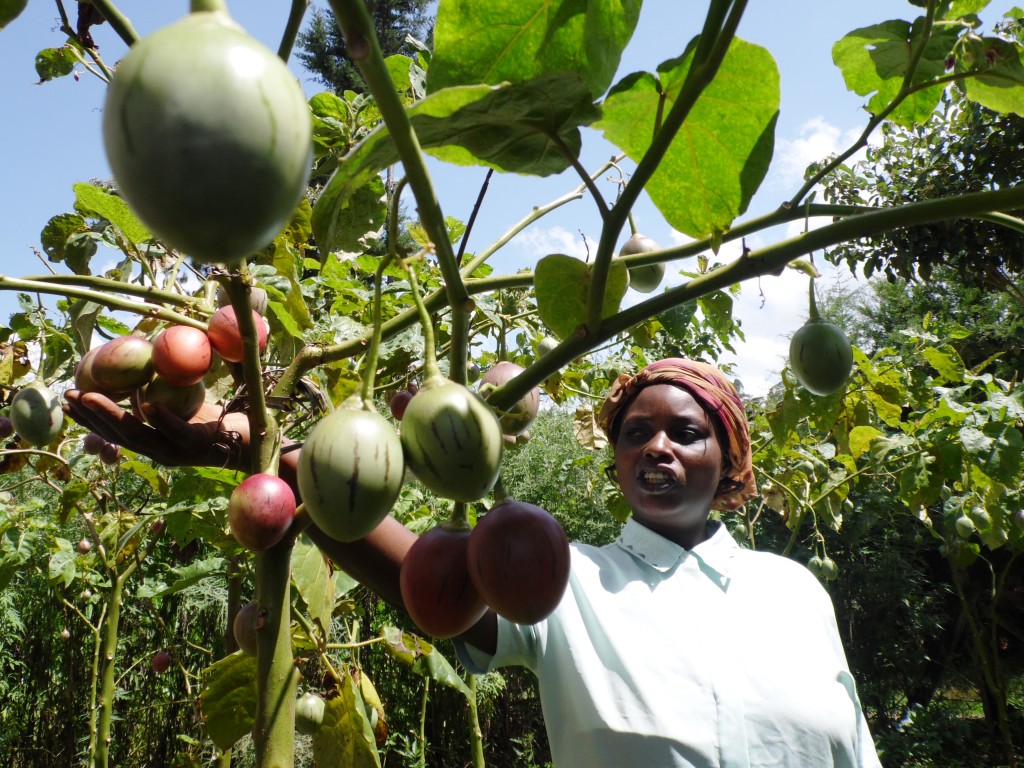Keziah Kiorio checking on tamarillo fruits at her home at Tetu, Nyeri County. She does not regret leaving maize growing for tamarillos, which are on constant demand. Photo by Laban Robert
In beating the high production costs of maize and its low returns, Keziah Kiorio turned into tomato tree farming, a crop that requires less labour and a fair market.
The tomatoes, which she has grown like flowers around the house and in the orchard, are earning her more money, which she uses to buy maize for her family.
The farmer, who also runs a nursery bed for other fruits, together with her husband, Jesse Kiorio, grafted the tomato with a bush tree that is not susceptible to diseases.
The tree tomato is commonly known as tamarillo and one kilo of the fruit sells at between Sh100 and Sh140. The cost per kilo varies from one customer to the other.
“My husband has customers in Nairobi. They make orders, which he delivers on Mondays as he goes to work. With a little irrigation, the harvest is through the year,” the Nyeri County farmer said.
One tamarillo can give up to 30 fruit at a time. She needs six to seven fruits to make one kilo.
Besides those tomatoes around their two houses, the crops have invaded the tea and vegetable orchard.
The about a quarter on an acre piece, where she used to grow maize for her family, is under pepino melons and the towering tamarillos.
She says they do not need to have a separate space since each can grow and give fruits just above the main crop.
“One tree can give about 20 kilogrammes per year. Selling each kilo at Sh100 translates to Sh2,000 With one tree I can buy a 90kg maize bag when the price is low, more so after harvests. I do not need to set aside more land for the maize when I can easily buy it from the earnings of fruits,” Keziah says.
From her quarter an acre piece of land for maize, she hardly harvested a half of the 90kg bag per season, which runs for eight months. Maize farmers in Kenya spend between Sh1,600 and Sh2,100 to produce one 90kg bag.
She has about 300 trees and more seedlings are available for sale. A mature tamarillo tree can be as high seven feet, and it needs no support.
READ ALSO: Former medical delivery man finds millions in tree tomatoes
READ ALSO: Demand spikes as bitter melon linked to cancer cure
READ ALSO: Making more than Sh60,000 per month from pepino melon
The ones growing around the kitchen are the tallest among his crop as a result of the kitchen water that is poured from time to time. The fruits are also bigger and more per tree than those around the tea plantation.
She dislikes maize because of the resources required to produce one sack, which must be taken good care of to avoid post-harvest losses. Post harvest losses arise from weevils, rats and other pest attacks. If the maize has more than 12.5 per cent moisture content, it can also be attacked by aflatoxins - fungi that poison food - rendering it inedible by animals and humans.
The grafted type is tolerant to low moisture content in addition to high yields as well as prolonged production period of up to 10 years.
Even with depressed rain and limited irrigation, the fruits have done well, with most of them having more than 20 mature fruits and many others at different development stages.
“We graft hybrid tamarillo with bitter leaf to give rise to a drought tolerant variety. The seedlings are also nematode resistant, making them better than hybrid ones sold by agro-input firms,” she says.
Together with her husband, they sell the seedlings at Sh200 raised in a greenhouse.
For high productivity, the Tetu Village farmer says one needs to dig a hole of three feet by one foot square before filling it with compost manure. The manure prolongs water retention ability by the soil. This reduces water wastage after irrigation or rains.
Keziah can be reached on +254722535987

















Comments powered by CComment